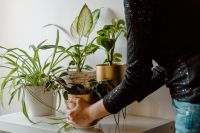
Houseplants add beauty to our homes, and they’re good for us too, helping to reduce stress and boost our moods. To help you keep your houseplants looking their best, we’ve put together some tips on basic houseplant care.
The right temperature for houseplants
Many of our favourite indoor plants come from tropical or subtropical areas of the world, so they prefer a warm environment. However, there are a few things to remember when trying to find a warm spot for your plant.
Don’t put plants near radiators, as the heat will dry them out and burn their leaves. Sunny windowsills are a good option, but be aware that direct, hot sunlight through glass can scorch even tropical plants' leaves. Windowsills can also get very cold on winter nights. Place your houseplant somewhere with a reasonably steady temperature, typically between 18-22°C (64-71°F).
Light levels for houseplants
All plants need light, but too much bright light can damage houseplants. Most houseplants do best in bright but indirect light, shaded by blinds or placed on an east- or west-facing windowsill. A south-facing windowsill that gets full sun is best suited to desert plants such as cacti and other succulents.
Flowering plants need more light than foliage plants and may need to be moved to a brighter spot in winter when light levels are lower.
Yellowing and dropping leaves, elongated stems and small leaves are all signs that your plant is not getting enough light. On the other hand, too much light can cause brown leaf tips or brown scorched patches on leaves. Keep an eye on your plants and move them if you see signs of too much or too little light.
Houseplants and humidity
Houseplants that originate from the tropics like humidity. Central heating can dry out the atmosphere in our homes, so to increase the humidity around your plant, follow these tips:
- Stand pots on trays of pebbles covered with water.
- Mist plants regularly.
- Group plants together to create a microclimate.
Watering houseplants
Watering houseplants can be tricky – in fact, overwatering is probably the most common cause of death for houseplants. Here’s how to spot the signs of over-and under-watering.
Signs that your plant needs watering:
- Wilting leaves
- Brown leaf edges
- Dropping leaves
- Pot feels light when picked up
Signs that your plant is being overwatered:
- Dropping leaves
- Brown, mushy roots
- Standing water in the drip tray
Test the moisture level in your plants’ pots by pushing your finger into the compost to feel whether it is damp below the surface. Most houseplants do best in slightly moist compost, but not wet. For large, deep pots, you may find it easier to use a soil moisture meter with a probe that can be pushed into the compost without damaging plant roots.




